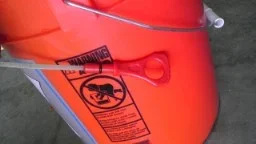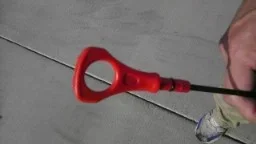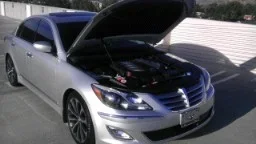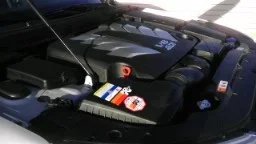My '12 - 5.0 sitting at a little over 11k miles, about another couple hundred miles before oil change is due...not sure what level oil is at but on hard stops and goes and/or turns my oil light come on then go off within 3 secs. I would imagine mine is down half if not more...
-

-
Hint: Use a descriptive title for your new message
If you're looking for help and want to draw people in who can assist you, use a descriptive subject title when posting your message. In other words, "I need help with my car" could be about anything and can easily be overlooked by people who can help. However, "I need help with my transmission" will draw interest from people who can help with a transmission specific issue. Be as descriptive as you can. Please also post in the appropriate forum. The "Lounge" is for introducing yourself. If you need help with your G70, please post in the G70 section - and so on... This message can be closed by clicking the X in the top right corner.
- Genesis Forums
- Hyundai Genesis Sedan Forums - 3.8 V6, 4.6 V8, 5.0
- General 2009-2014 Hyundai Genesis Sedan Discussion
You are using an out of date browser. It may not display this or other websites correctly.
You should upgrade or use an alternative browser.
You should upgrade or use an alternative browser.
Oil Consumption in '12 R-Spec
- Thread author Timothy_Gee
- Start date
-
- Tags
- 12 consumption oil rspec
STREETS
Registered Member
Like Yellow, today's high-tech engines should not eat, drink, smoke oil, especially any outrageous amounts discussed herein.
Demand a engine replacement.
Demand a engine replacement.
Mark_888
Registered Member
- Joined
- Jan 9, 2009
- Messages
- 13,335
- Reaction score
- 224
- Points
- 63
- Genesis Model Type
- 1G Genesis Sedan (2009-2014)
You had better put some in oil in immediately before the next oil change, else you are going to be in a heap of trouble if there is problem. It is your responsibility to check the oil level between oil changes. Letting it get that low can ruin an engine and a warranty claim might be denied if you didn't check your oil level.My '12 - 5.0 sitting at a little over 11k miles, about another couple hundred miles before oil change is due...not sure what level oil is at but on hard stops and goes and/or turns my oil light come on then go off within 3 secs. I would imagine mine is down half if not more...
homeofstone
Registered Member
My '12 - 5.0 sitting at a little over 11k miles, about another couple hundred miles before oil change is due...not sure what level oil is at but on hard stops and goes and/or turns my oil light come on then go off within 3 secs. I would imagine mine is down half if not more...
An oil light coming on is a serious warning. Shut the engine down and check oil level ASAP. Add oil as necessary. Never, never drive any car with an oil warning light coming on, the engine will be damaged.
mikec
Registered Member
- Joined
- Apr 30, 2009
- Messages
- 712
- Reaction score
- 118
- Points
- 43
- Location
- SoCal
- Genesis Model Type
- Genesis GV80
I don't know the Tau 5.0 setup but I have general engine knowledge/experience from many other cars. Get a small flashlight and eyeball the hoses/pipes going to the oil cooler. Often a small leak on those fittings is hard to spot because oil may not flow through the oil cooler until an oil-specific thermostat says the oil is hot. So running in the driveway may not get the oil hot enough to have it pumped through the cooler. Several high-speed highway miles should do the trick.
A problem in the engine's crankcase breather system (PCV) and/or excessive blow-by that pressurizes the crankcase shoves oil through the PCV valve where it ends up getting burned and expelled with the exhaust. A cylinder leak-down test (dealers know what this is) will easily identify a cylinder with bad/defective piston rings; leak-down tests are more reliable than simple compression tests. In a nutshell, the leakdown test is:
1: remove the spark plugs
2: manually rotate the engine so the cylinder being tested is at "top dead center" which means the piston is all the way UP, all intake & exhaust valves are closed, etc... in the normal 4-stroke cycle the "power stroke" would be about to begin.
3: an air compressor hose connects to the spark plug hole via a mechanism with two pressure gauges and a small valve/orifice between them. This orifice limits how quickly air can move through the mechanism. Imagine filling a plastic bucket with a garden hose turned on full-blast - it'll fill quickly, right? If that bucket had a quarter inch diameter hole in the bottom you'd still be able to fill it with the hose on full-blast but it'll take a little longer. Next, imagine trying to fill that bucket (with the hole) while the faucet is barely turned on: that little hole may drain faster than you can fill the bucket. The leak-down tool's "orifice" mimics the faucet being barely turned on. The quarter-inch hole represents leaks in the piston rings and/or valves of an engine cylinder. In a healthy engine, the hole is really tiny - i.e. there are only very minor leaks inside the engine - so the air pressures before and after the orifice end up pretty close (bucket is full). If the engine leaks more than it should, the second pressure gauge will read low because the orifice-limited airflow can't fill up the cylinder.
By the way: "blow-by" is air+fuel combustion products that squeeze past the piston rings and end up in the crankcase. All engines have a little blow-by; worn or defective engines have a lot more. The PCV system allows these fumes to get sucked into the intake manifold of the engine where those fumes will then get sent to the cylinders again to be burned. The PCV system flows a little bit of air volume... which is supposed to be much higher than the "normal" blow-by volume. This keeps the engine crankcase (area below the pistons, where the oil and crankshaft live) at a slight vacuum. Excessive blow-by though overwhelms the PCV, causing combustion pressures to build up in the crankcase. That in turn shoves the oil around, possibly through the PCV valve where the oil gets burned... or it shoves oil past the various engine seals/gaskets leading to a messy engine and stains on the garage floor.
I've also seen engines that use "oil separator" devices (again, I don't know if the Tau 5.0 has one; many turbocharged engines do though since PCV systems can't work with a turbo-pressurized intake manifold) leak. The oil separator basically separates crankcase fumes from atomized oil - it's just a tank with 3 ports: inlet from the crankcase that may have oil droplets along with the blow-by gasses, a drain at the bottom that sends separated/captured oil (from those droplets) back to the oil pan, and a port mid-way up that hooks to a non-pressured part of the intake tract. If the oil drain hose is missing, you'll have a slow oil leak ONLY during conditions where the PCV can't function - i.e. high-power driving - so it's hard to diagnose in the shop/garage.
mike c.
A problem in the engine's crankcase breather system (PCV) and/or excessive blow-by that pressurizes the crankcase shoves oil through the PCV valve where it ends up getting burned and expelled with the exhaust. A cylinder leak-down test (dealers know what this is) will easily identify a cylinder with bad/defective piston rings; leak-down tests are more reliable than simple compression tests. In a nutshell, the leakdown test is:
1: remove the spark plugs
2: manually rotate the engine so the cylinder being tested is at "top dead center" which means the piston is all the way UP, all intake & exhaust valves are closed, etc... in the normal 4-stroke cycle the "power stroke" would be about to begin.
3: an air compressor hose connects to the spark plug hole via a mechanism with two pressure gauges and a small valve/orifice between them. This orifice limits how quickly air can move through the mechanism. Imagine filling a plastic bucket with a garden hose turned on full-blast - it'll fill quickly, right? If that bucket had a quarter inch diameter hole in the bottom you'd still be able to fill it with the hose on full-blast but it'll take a little longer. Next, imagine trying to fill that bucket (with the hole) while the faucet is barely turned on: that little hole may drain faster than you can fill the bucket. The leak-down tool's "orifice" mimics the faucet being barely turned on. The quarter-inch hole represents leaks in the piston rings and/or valves of an engine cylinder. In a healthy engine, the hole is really tiny - i.e. there are only very minor leaks inside the engine - so the air pressures before and after the orifice end up pretty close (bucket is full). If the engine leaks more than it should, the second pressure gauge will read low because the orifice-limited airflow can't fill up the cylinder.
By the way: "blow-by" is air+fuel combustion products that squeeze past the piston rings and end up in the crankcase. All engines have a little blow-by; worn or defective engines have a lot more. The PCV system allows these fumes to get sucked into the intake manifold of the engine where those fumes will then get sent to the cylinders again to be burned. The PCV system flows a little bit of air volume... which is supposed to be much higher than the "normal" blow-by volume. This keeps the engine crankcase (area below the pistons, where the oil and crankshaft live) at a slight vacuum. Excessive blow-by though overwhelms the PCV, causing combustion pressures to build up in the crankcase. That in turn shoves the oil around, possibly through the PCV valve where the oil gets burned... or it shoves oil past the various engine seals/gaskets leading to a messy engine and stains on the garage floor.
I've also seen engines that use "oil separator" devices (again, I don't know if the Tau 5.0 has one; many turbocharged engines do though since PCV systems can't work with a turbo-pressurized intake manifold) leak. The oil separator basically separates crankcase fumes from atomized oil - it's just a tank with 3 ports: inlet from the crankcase that may have oil droplets along with the blow-by gasses, a drain at the bottom that sends separated/captured oil (from those droplets) back to the oil pan, and a port mid-way up that hooks to a non-pressured part of the intake tract. If the oil drain hose is missing, you'll have a slow oil leak ONLY during conditions where the PCV can't function - i.e. high-power driving - so it's hard to diagnose in the shop/garage.
mike c.
An oil light coming on is a serious warning. Shut the engine down and check oil level ASAP. Add oil as necessary. Never, never drive any car with an oil warning light coming on, the engine will be damaged.
I understand the risk but I believe a car under warranty, and getting services by dealer by the book that I should have to monitor my oil, it's reidicious! I pay the extra premium for dealer to change oil etc...now u saying I have to add, bs!
homeofstone
Registered Member
I understand the risk but I believe a car under warranty, and getting services by dealer by the book that I should have to monitor my oil, it's reidicious! I pay the extra premium for dealer to change oil etc...now u saying I have to add, bs!
An owner not paying attention to an oil warnng light and following instructions in the manual is negligent under the warranty and repairs will not be covered under warranty. The following is directly from your owner's manual.
"If the oil pressure warning light stays on while the engine is running, serious engine damage may result. The oil pressure warning light comes on whenever there is insufficient oil pressure. In normal operation, it should come on when the ignition switch is turned on, then go out when the engine is started. If the oil pressure warning light stays on while the engine is running, there is a serious malfunction. If this happens, stop the car as soon as it is safe to do so, turn off the engine and check the oil level. If the oil level is low, fill the engine oil to the proper level and start the engine again. If the light stays on with the engine running, turn the engine off immediately. In any instance where the oil light stays on when the engine is running, the engine should be checked by an authorized HYUNDAI dealer before the car is driven again. "
homeofstone
Registered Member
5 Dumb things that can void a car warranty
here is the link to an AOL article.
http://autos.aol.com/article/5-things-will-void-car-warranty/
here is the link to an AOL article.
http://autos.aol.com/article/5-things-will-void-car-warranty/
Crusty Old Shellback
Registered Member
One other comment, most people baby their cars too much on break in. Some higher rpm use and varied speeds are best. Most engines need to used at at least 50% capacity durring break in. The reason for the early oil change is to remove all the assembly swarf, and machining residue. After that WAIL! Racing engines I've built have been run hard, even near redline in the first session on the track and wheen tearing down for modification later show no abnormal wear, in fact they often look better than street cars.Bill
I agree with you 100 %.
When I built my 600 HP blown Small Block Chevy, I had some concerns about breakin. I talked to my machinist about it. He just happens to be one of the top engine builers for the local outlaw cars as well as the lead mechaninc for Lucas oils drag boat.
I asked him if I should run the motor without the blower while I was breaking it in. His answer was break it in like your going to run it. Leave the blower on and don't baby it. The initial start up is the most critical. Set everything and run it at 2K RPMS for 5 mins to set the cam wear.
I did just as he sugested and didn't have any issues with the motor. Even when I tore it down after 20K miles to sell the parts, everything still looked brand new.
I did the same with a '08 V6 Pontiac when I bought it new, drove it like I stole it. When the dealer took the motor apart because of their so called mechanic had no clue what he was doing, the motor still looked new at 45K miles.
stpetermi
Hasn't posted much yet...
Guys - doesn't the RSPEC take 7.1 quarts or something around there to fill 'er up? Maybe someone who didn't know only put in 5 quarts when the oil was changed as this is common practice and most cars don't take over 7 quarts...
My 2 cents
The manual states for the 2012 5.0 if you have an 'orange" dip stick the the capacity is 7.19 and if you have a "red" dip stick the capacity is 7.61 qts. I'm a little color blind so I can't tell if my dip stick is orange or red??? Kinda like a little pregnant....
2012 RSpec
Hasn't posted much yet...
- Joined
- Dec 14, 2012
- Messages
- 7
- Reaction score
- 0
- Points
- 0
Four (4) Oil Changes later and using a quart between every change.
jnc2000
Registered Member
Four (4) Oil Changes later and using a quart between every change.
Which OE's will tell you is within consumption limits....
chicagorspec
Getting familiar with the group...
This got me curious. My R-Spec has an orange dipstick, but seems odd that two cars with the same engine could have two different oil capacities. FWIW, the orange color of mine is quite light, nowhere close to red, if your better half or someone other can take a look at it for you.
The manual states for the 2012 5.0 if you have an 'orange" dip stick the the capacity is 7.19 and if you have a "red" dip stick the capacity is 7.61 qts. I'm a little color blind so I can't tell if my dip stick is orange or red??? Kinda like a little pregnant....
Mark_888
Registered Member
- Joined
- Jan 9, 2009
- Messages
- 13,335
- Reaction score
- 224
- Points
- 63
- Genesis Model Type
- 1G Genesis Sedan (2009-2014)
They may tell you that (in order to avoid a warranty claim), but apparently many R-Spec owners are not experiencing any measurable oil consumption between changes. Years ago such consumption may have been normal for almost all engines, but that is no longer the case.Which OE's will tell you is within consumption limits....
Mark_888
Registered Member
- Joined
- Jan 9, 2009
- Messages
- 13,335
- Reaction score
- 224
- Points
- 63
- Genesis Model Type
- 1G Genesis Sedan (2009-2014)
Could that the difference between the Genesis 5.0 and Genesis R-Spec, both with Tau V8 5.0 engine, but maybe one has a larger oil pan (and maybe some other minor differences)?The manual states for the 2012 5.0 if you have an 'orange" dip stick the the capacity is 7.19 and if you have a "red" dip stick the capacity is 7.61 qts. I'm a little color blind so I can't tell if my dip stick is orange or red??? Kinda like a little pregnant....
Looking to update and upgrade your Genesis luxury sport automobile? Look no further than right here in our own forum store - where orders are shipped immediately!
jnc2000
Registered Member
They may tell you that (in order to avoid a warranty claim), but apparently many R-Spec owners are not experiencing any measurable oil consumption between changes. Years ago such consumption may have been normal for almost all engines, but that is no longer the case.
I agree... but until OE's change the process on which they validate oil consumption claims this won't change. This means the owner is the little man - who ends up fighting not the dealership, but HMA on the basis of a warranty being denied. Dealers can not deny, nor invalidate a warranty. They are authorized under HMA to operate as a selling and servicing agent.
Also keep in mind most dealers don't like doing engine / transmission warranty claims as this goes against their stats.
jnc2000
Registered Member
Could that the difference between the Genesis 5.0 and Genesis R-Spec, both with Tau V8 5.0 engine, but maybe one has a larger oil pan (and maybe some other minor differences)?
I have an R-spec with the orange dip stick... always measured out my .2 of a quart (190ml) with a measuring cup to be exact....
stpetermi
Hasn't posted much yet...
Could that the difference between the Genesis 5.0 and Genesis R-Spec, both with Tau V8 5.0 engine, but maybe one has a larger oil pan (and maybe some other minor differences)?
Here's some pics of my oil dip stick... My wife and daughters agree the color of the dip stick is more red than orange color. Pic next to HD orange bucket. You all can judge and let me know what you think. Bottom line I check it daily to make sure it is at the proper level as I tend to drive her hard at times...
Attachments
Crusty Old Shellback
Registered Member
OK, looks like mine is using oil as well. My oil light just came on briefly so I stopped and checked it. 2 quarts low after 5k miles of driving. I also remember checking the oil the day after my dealer did my last oil change and noticed that it seemed high. I had checked it when it was cold in the morning before starting the car. dealer said it was just fine. car now has 15K miles on it and it due for an oil change.
One reason for the oil consimpution that I just thought of, for me anyways, is that I only live 5 miles from work so the car dosen't really get warmed up by the time I get to work. That and I do a lot of short drives, less than 2 miles, during the day while at work. That may account for the extra oil consumption. I see no oil spots on the ground under the car when parked.
And as for the dip stick, mine is difenatly orange. I'll start paying closer attention to it now.
One reason for the oil consimpution that I just thought of, for me anyways, is that I only live 5 miles from work so the car dosen't really get warmed up by the time I get to work. That and I do a lot of short drives, less than 2 miles, during the day while at work. That may account for the extra oil consumption. I see no oil spots on the ground under the car when parked.
And as for the dip stick, mine is difenatly orange. I'll start paying closer attention to it now.
STREETS
Registered Member
This does not seem normal at all.
Great products:
- VIN Check
- Add more horsepower!
- Clean your leather!
- Safe Emergency Charging
- Windshield Repair Kit
- Chemical Guys HydroSpeed Ceramic Quick Detailer
- Chemical Guys HydroCharge High-Gloss Hydrophobic SI02 Ceramic Spray Coating
- Get a dash cam!
- Auto Buyers Market
- Foreign invaders vs USA gangs
- VIN Check
- Add more horsepower!
- Clean your leather!
- Safe Emergency Charging
- Windshield Repair Kit
- Chemical Guys HydroSpeed Ceramic Quick Detailer
- Chemical Guys HydroCharge High-Gloss Hydrophobic SI02 Ceramic Spray Coating
- Get a dash cam!
- Auto Buyers Market
- Foreign invaders vs USA gangs
Featured content
-
-
Thread 'Help us to keep helping you. Your support is essential to our survival.'
- Sal Collaziano
Replies: 32












